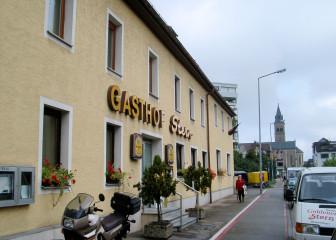Rothenburg is on a hill. So it goes first downhill to the Tauber and then uphill again on the other side of the valley, partly quite steep, so that I have to push. Finally arrived at the top, the path becomes reasonably flat and it goes on quite briskly. I am pleased about the scallops that accompany my way.
The sky is overcast. Sometimes I encounter wet roads. In the distance I see rain. But I myself am spared.
The next larger town is called Crailsheim. My first impression is that of a town destroyed in the war and rebuilt afterwards. There are hardly any old houses left in the town center. I pass the Liebfrauenkirche (Church of Our Lady), but the Johanneskirche (church of St. John) fascinates me and I visit it.
The present St. John's Church dates from 1398 to 1440 and was built on the model of a late Gothic mendicant church, the Franciscan church in Rothenburg/Tauber. Of the former 13 altars, the altar of St. John with the Crucified in the center, the Baptist John, the Mother Mary and the Apostles John and Andrew still adorns the choir of the church.
St. John's Church Portal
Of particular art-historical importance are the altarpieces, which show four scenes of the Passion of Christ on the inside and tell the life of John the Baptist on the outside. They come from the workshop of Michael Wolgemut, Albrecht Dürer's teacher (Nuremberg, late 15th century).
In the church you can admire a twelve-meter-high sacrament box from 1499, created by Crailsheim stonemason Andreas Embhardt. Near the main portal there are two uncovered wall paintings from the 15th century. They show the martyrdom of St. Sebastian (Völkerskapelle) and a dance of death (Empore).
View of the organ in the west gallery. It dates from 1709 and has been restored several times.
From Crailsheim to Jagstheim, the bike path corresponds to the Way of St. James. Then they separate. The decision is difficult for me, but I stay on the bike path because it is next to the railroad and therefore flat. The Jakobsweg, however, leads over very humpy terrain.
About 30 km further along the Way of St. James I come to Ellwangen. The city has a small old town center with beautiful town houses and an interesting double church. The baroque Protestant city parish church and the collegiate church of St. Vitus are built together. They overlap. I am very pleased with the beautiful Gothic cloister and the Romanesque porch of St.Vitus (St.Veit).
On the left of the (upper or left) picture you can see the towers of the baroque city parish church, in the center of the picture the originally Romanesque St. Vitus church. Inside it has also been baroqueized.
Another picture shows the Romanesque entrance to the St. Vitus Church.
St. Vitus Church was built between 1182 and 1233 and is the third church on this site, dating back to 764. This monumental building from the Staufer period is considered the most important Romanesque vaulted basilica in Swabia.
Cloister (south wing)
Cloister (east wing)
The Gothic cloister was built in 1468 - 1473. Each of the 29 windows has a slightly different work of fish bubble mass. In the west wing of the cloister is the Chapel of Our Lady.
Romanesque west porch of St. Vitus Church
Only three rooms remain from the Romanesque period: The west vestibule, St. Michael's Chapel above (inaccessible) and the crypt.
Two pictures from Ellwangen


After a purchase in the supermarket I continue again. It goes very, very steeply uphill. For a long time I have to push. Finally I arrive on a plateau and it goes lively there, until a place name sign. But this does not fit at all to my way! A horrible thought flashes through my mind. The steep mountain - all in vain. I have to go back and find the bike path to Wasseralfingen / Aalen.

My intended destination would be Aalen. But in Ellwangen I have lost a lot of time and it is getting late. So I start to look for a quarter, but find none. Only in Wasseralfigen I find signs. In the inn "Goldener Stern" I get a room, and what a room it is. There is a huge settee for at least 10 people. There is a huge TV and, funnily enough, two bunk beds. The bathroom is across the hall. I enjoy the stage beer and a fine dinner in the guest room.
After that I sleep wonderfully.